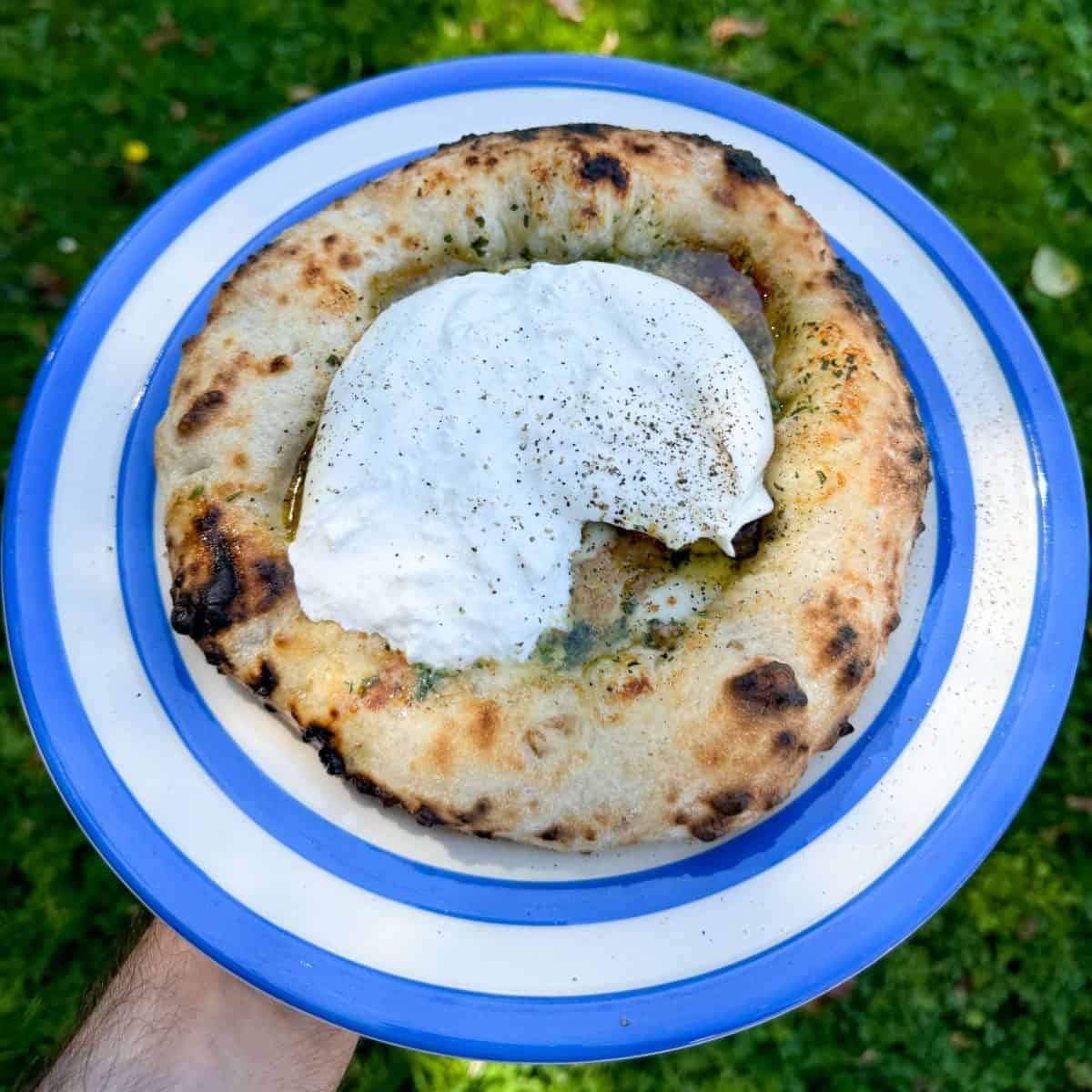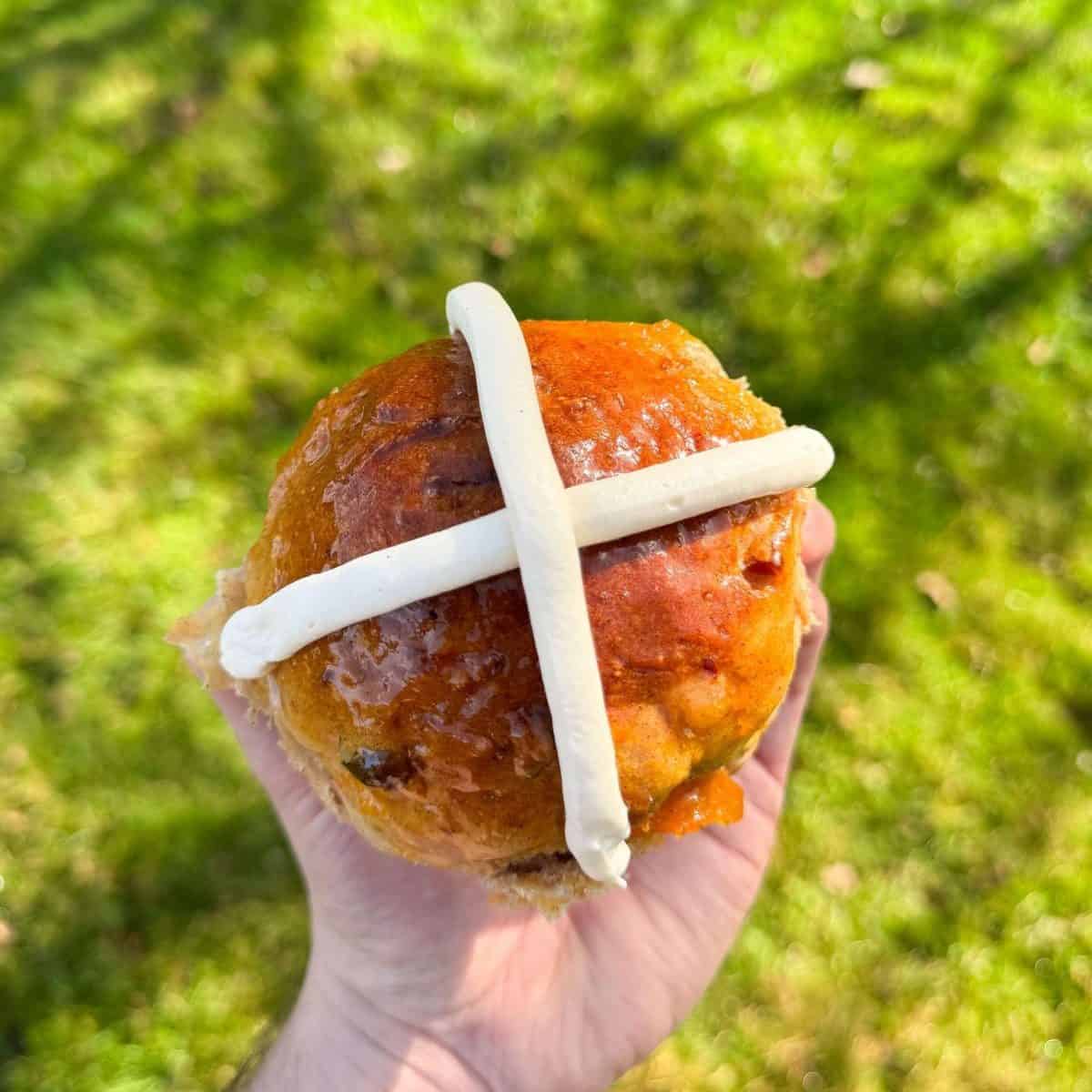100% Biga Potato Pizza Dough
This 100% biga potato pizza dough makes crisp, chewy & open crusts! Made with a pre ferment & baked potato, for extra flavour.
This post contains affiliate links.
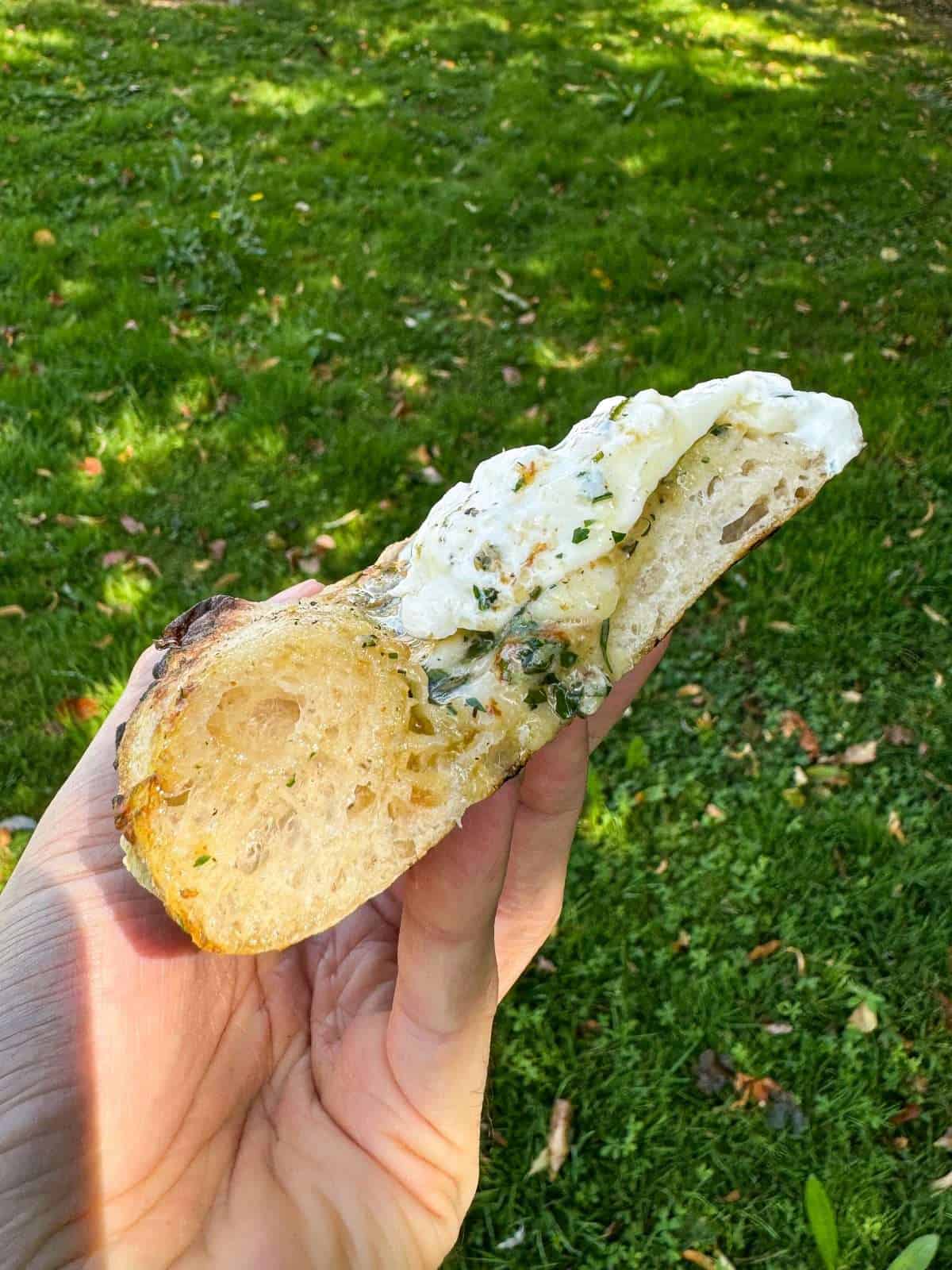
If you’re looking for a dough that makes next level pizzas, with fluffy open crusts, a pleasantly chewy texture & a well developed flavour, this is the recipe for you!
This 100% biga potato pizza dough makes the best crusts, especially when cooked in a pizza oven! To make this dough, we’re making use of a biga pre ferment & a long cold, prove in the fridge for maximum flavour & oven spring. In fact, we’re making this pizza dough over 3 days! Don’t worry though, most of this time is hands off…
As well as a biga, this dough contains potato. Both mashed & pieces of crispy skin! This makes our pizza crust even fluffier & crisp once baked. It also adds even more flavour & texture to the dough. Like in my potato burger buns & overnight potato focaccia recipes…
For more pizza dough recipes, as well as bread loafs, buns & rolls, take a look at our ever growing collection of bread recipes!
What Is A Biga?
A biga is a type of Italian pre ferment that is used instead of yeast (on its’ own) when making breads & pizzas. This is a low hydration pre ferment with a hydration of around 40-60%.
To make a biga, we mix cold water, yeast & 00 flour together by hand until the flour is just hydrated & it looks clumpy & shaggy. It’s important not to make a dough here! The biga is then left to ferment at 16°c-18°c (60°f-64°f) for 16-18 hours before using to make dough.
Biga vs Poolish
Both a biga & a poolish are types of pre ferments & are used in pretty much the same way. The main difference being their hydration levels. A biga will have a hydration of 40-60% (45% for our biga) and a poolish will be closer to 100% hydration. Therefore a biga is a stiff starter whereas a poolish is a liquid starter. These can both be used interchangeably just keep in mind that you’ll need to adjust the amount of liquid in your dough recipe.
Using Potato In Pizza Dough
I’m a massive fan of using potato in bread & pizza doughs!
This may seem a little strange but trust me it works! By using mashed potato in our pizza dough, we increase the starch content which allows more water to be added without making the dough overly wet & sticky. Using mashed potato (and a biga) in our dough gives the pizzas a fluffy, open crust & pleasantly chewy texture once baked.
To prepare, we’re going to baking a whole skin on potato, until the inside is cooked & the skin is crispy. The potato gets mashed with a ricer (or a fork) & the crispy skin gets chopped into small pieces. Both are then added to the dough for extra flavour!
On average, a baked potato will contain around 75% water. This info comes in handy when we want to work out how this affects the hydration of our dough.

What You’ll Need
- 00 Flour – We’re using 00 flour, for the airiest crust & a slightly chewy texture. For cold fermented doughs, I like to use Caputo (in this case the Pizzeria flour). I’ve linked this further down in the post…
- Yeast – I’d recommend using dried active yeast for this style of pizza dough. As we’re making a biga (pre ferment), you’ll only need a small amount.
- Potatoes – Make sure to use a floury potato for this pizza dough. I like to use Maris Pipers but Russet or King Edward potatoes will work as well. You’ll need 120 grams of mash for the dough, so I’d recommend baking a potato that weighs around 200 grams when raw.
- Salt – A good quality, fine sea salt works best for pizza dough. I use Maldon salt.
- Water – We’re using cold tap water for our biga & pizza dough. The water’s temperature should be around 20°c/68°f.
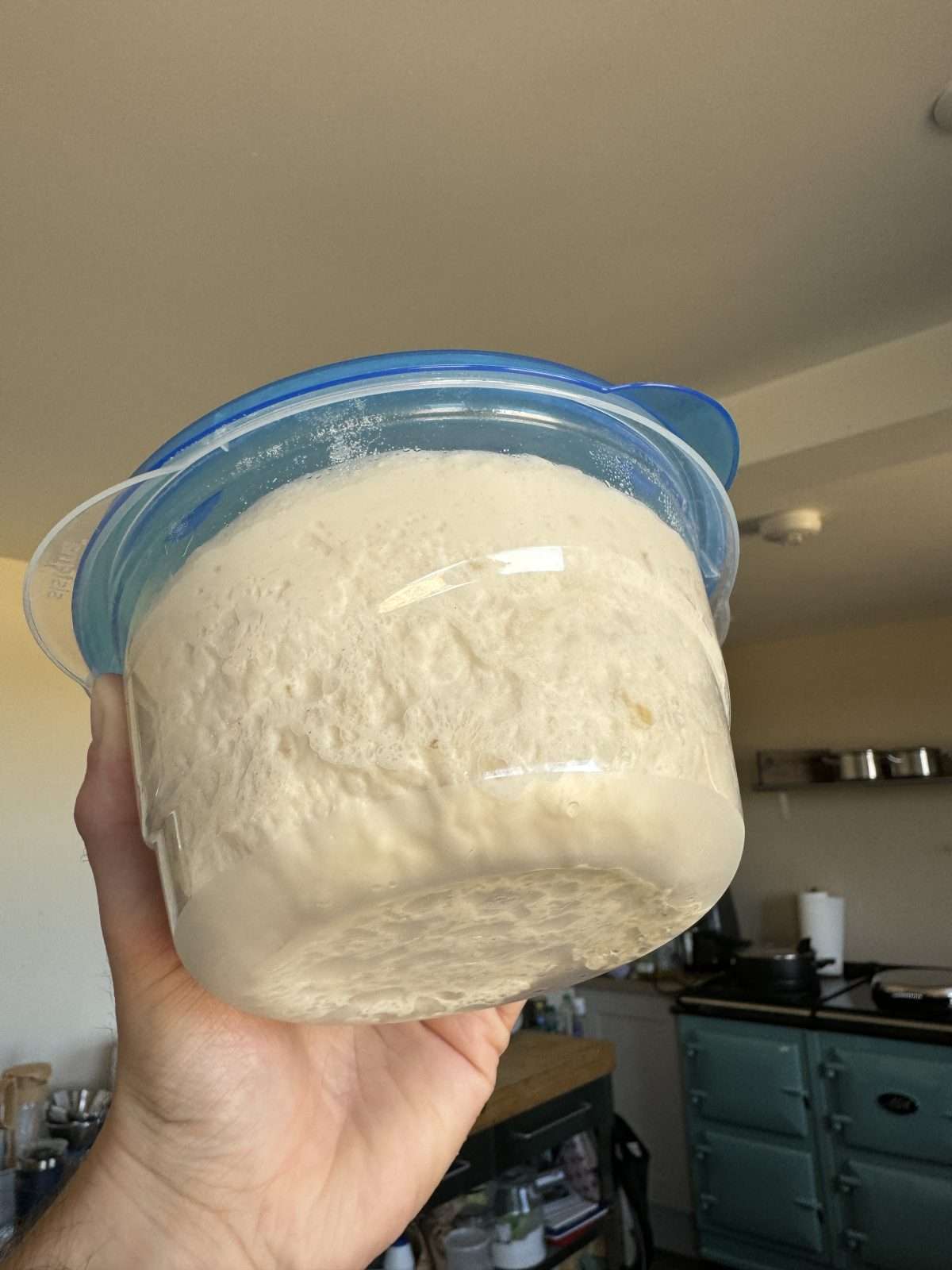
Baker’s Percentages
When working with a dough recipe, we calculate each ingredient using baker’s percentages. This is the amount of each ingredient (water, salt, yeast, etc.) in relation to how much flour the recipe uses (the total flour weight). This makes it easy to scale the recipe up if you want to make a larger batch.
Here’s the baker’s percentages for our 100% biga potato pizza dough.
- 100% Biga (made with all of the dough’s flour)
- 20% Mashed Potato (replaces 20% of the flour)
- 65% Hydration (including moisture from the potato)
- 2.5% Sea Salt
- 0.5% Dried Active Yeast
How To Make 100% Biga Potato Pizza Dough
The full, printable recipe card for this pizza dough can be found at the bottom of this post! Here’s a quick rundown of the recipe…
1. The Biga
We’re making this pizza dough over 3 days, with the biga being made on day 1.
To make a biga, we add dried active yeast & cold tap water (the water’s temperature should be around 20°c/68°f) into a mixing bowl then whisk, to combine. Next, we add in 00 flour then mix by hand, just to hydrate the flour (not make into a dough – be careful not to over mix!). The biga should look clumpy & shaggy!
We then cover the bowl with clingfilm, poke a small hole in the top then leave the biga to ferment at 16°c-18°c (60°f-64°f) for 16-18 hours. This is a cool room temperature!
We’re making a 100% biga pizza dough, which means that our biga is made with all of the dough’s flour.
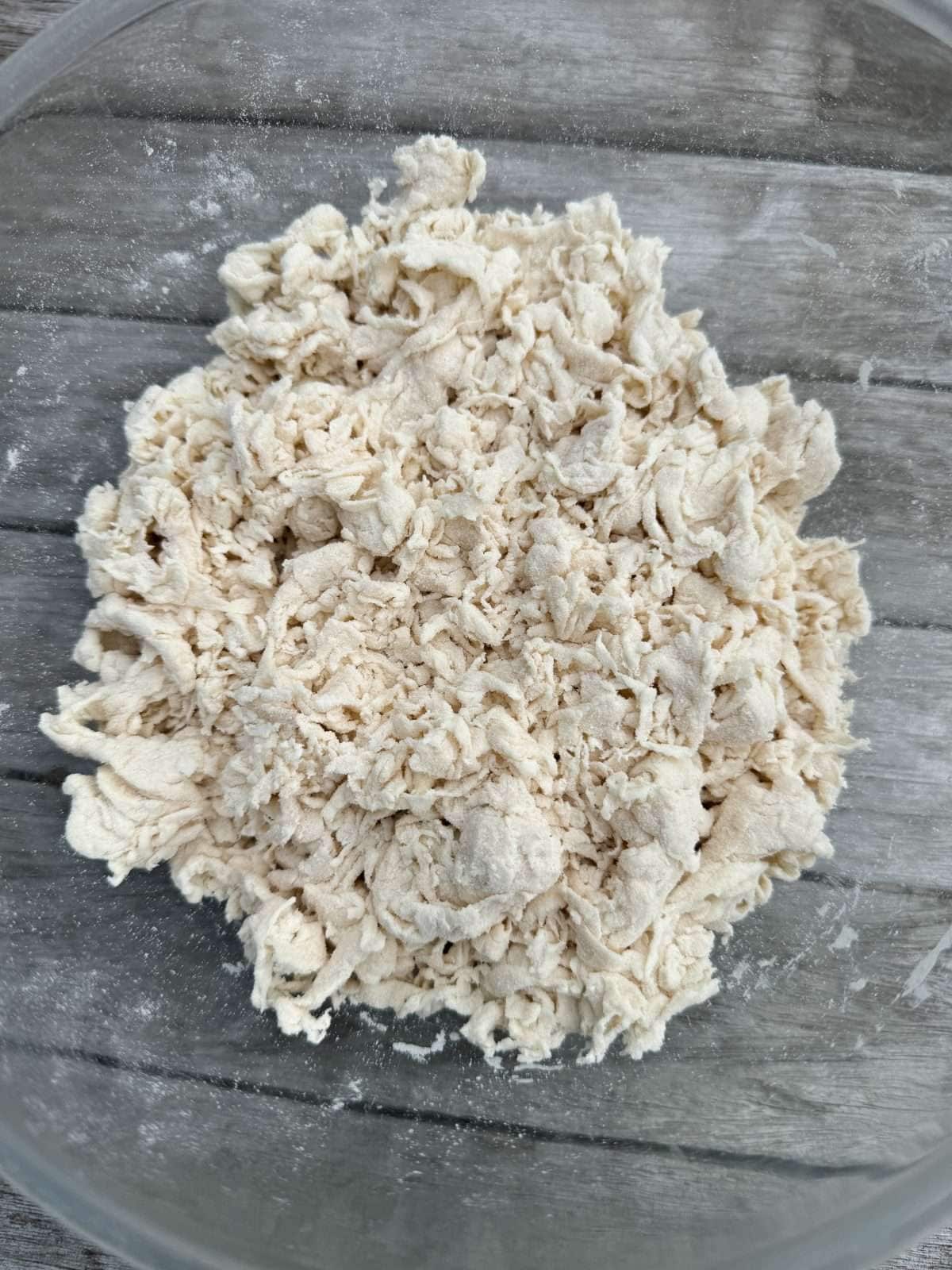
2. Mixing The Dough
Before we mix our dough, we need to roast a large potato until the inside is cooked & the skin is crispy. This will take 30 minutes – 1 hour at 200°c/390°f. Once cooked, we scoop the potato out of the skin, mash then weigh out 120 grams. We then chop the crispy potato skin into small pieces & let both cool to room temperature.
To make the dough, we transfer the biga into the bowl of a stand mixer then add in 40 grams of cold tap water & the potato. We then mix on a low speed for 4-5 minutes, until combined & smooth then add in sea salt & another 45 grams of cold water (adding the water in 2 stages, helps it incorporate better). We then mix the dough on low, to incorporate the salt & water then turn the speed up to medium & mix until the dough passes the windowpane test. This will take another 5 minutes or so, of mixing.
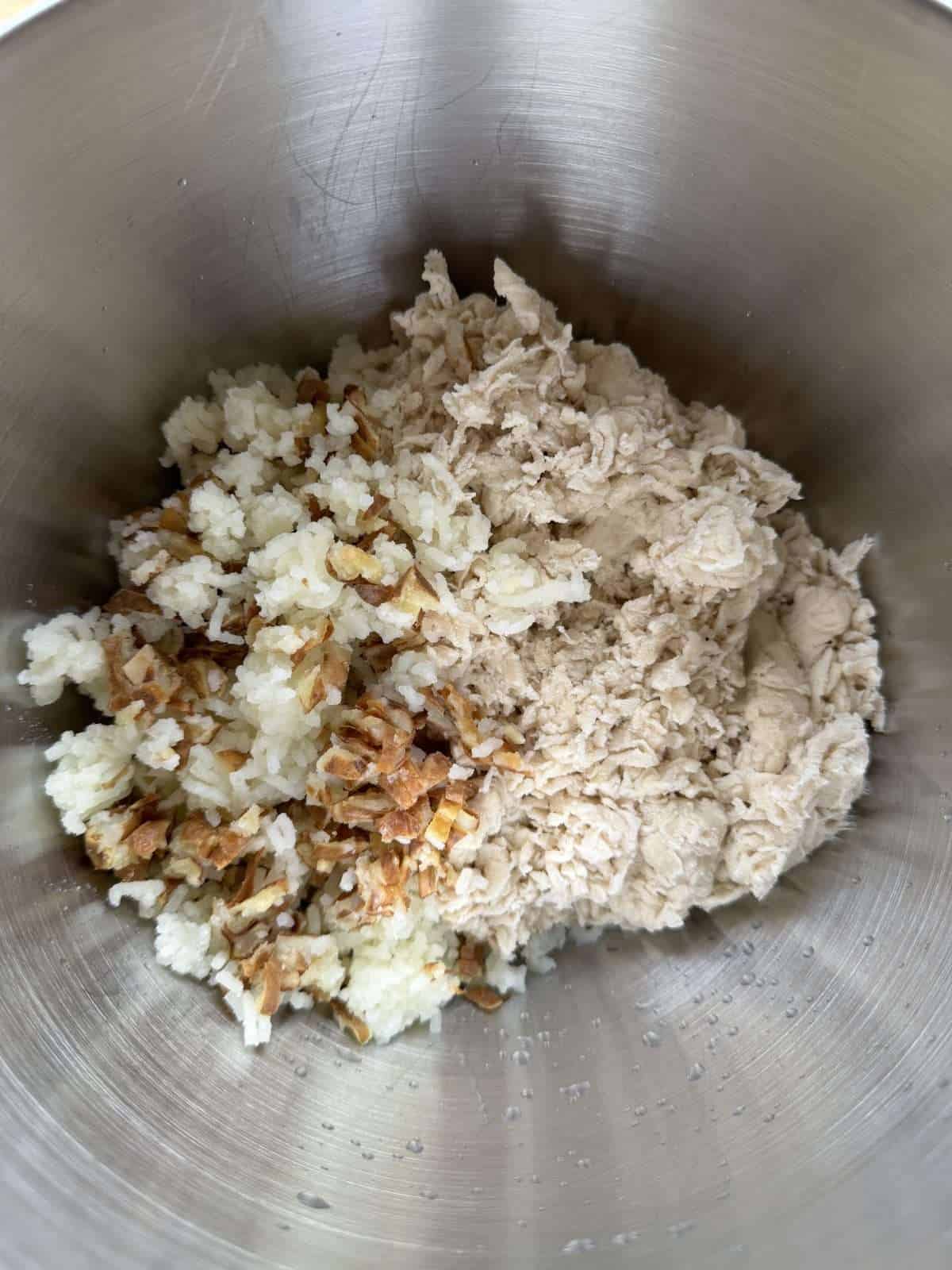

3. Leave At Room Temperature
Once our dough is mixed, we transfer it to a lightly oiled mixing bowl then leave to sit at room temperature for 40 minutes. After 20 minutes, I like to give the dough a set of coil folds, to strengthen but this is optional.
4. Shaping Into Balls
Next, we divide the dough into 4 equal pieces, each weighing around 230 grams. We shape the dough into balls then transfer each one into a lightly oiled pot (or into a dough tray).
5. Cold Ferment
Once shaped, we pop the dough balls into the fridge then leave to cold ferment for 18-24 hours. You’ll when the dough has fermented because they will have risen in the pots & you’ll see lots of air bubbles in the dough.
Before using the dough, it needs to come back to room temperature (this is called tempering the dough). This will take around 1-2 hours. Be careful not to let it sit out for too long though, as this will affect how it rises as it bakes.
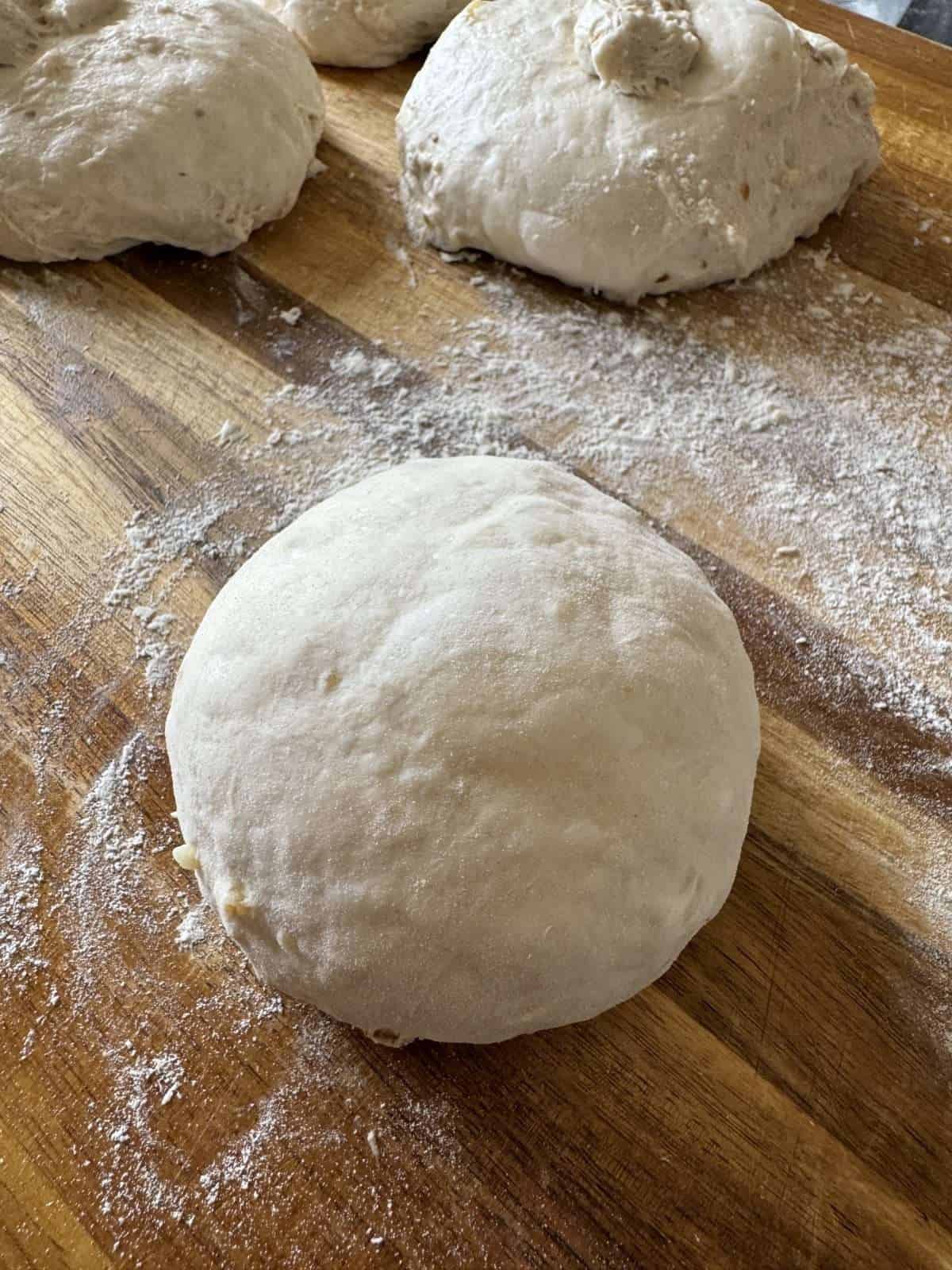
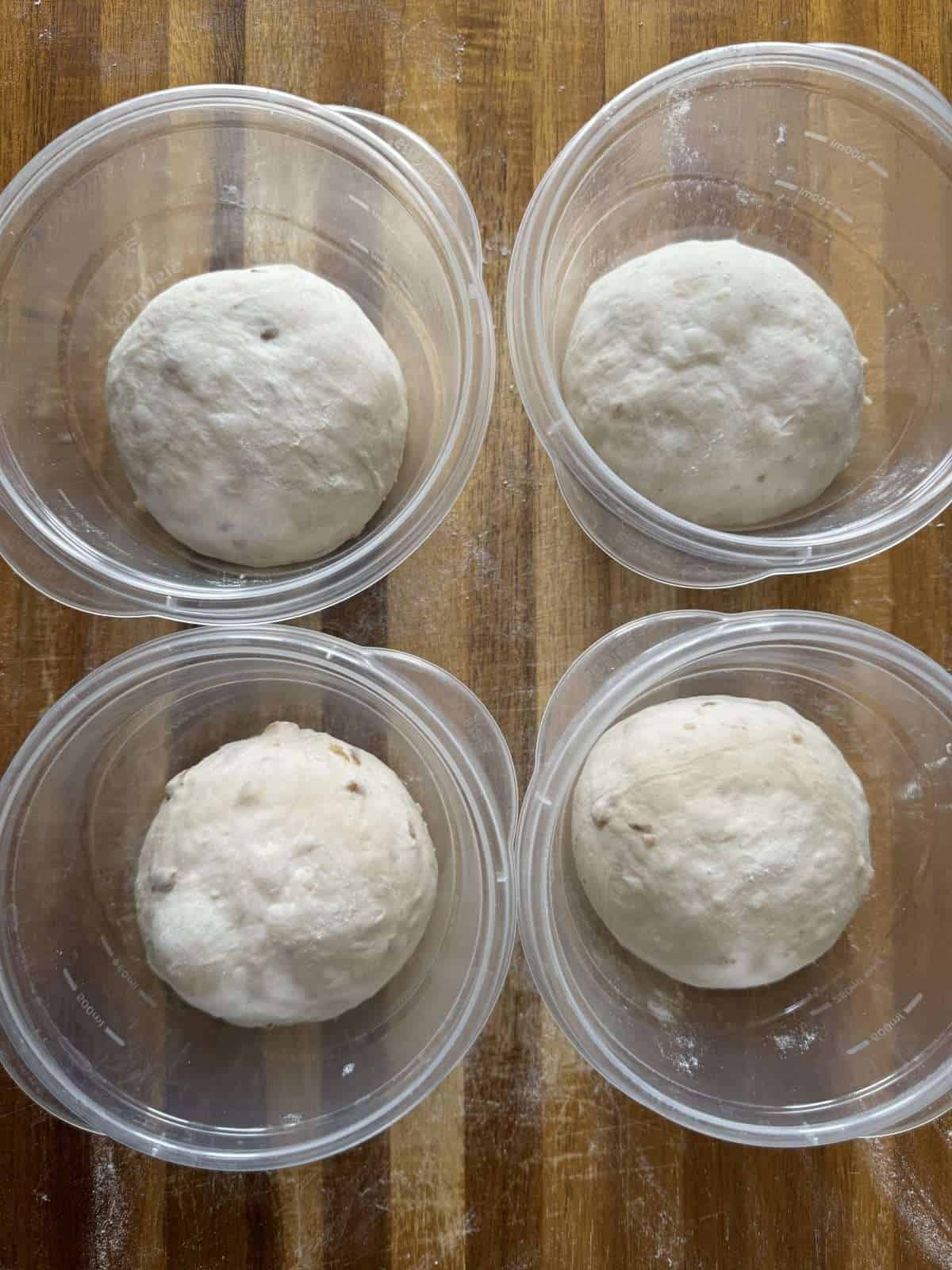
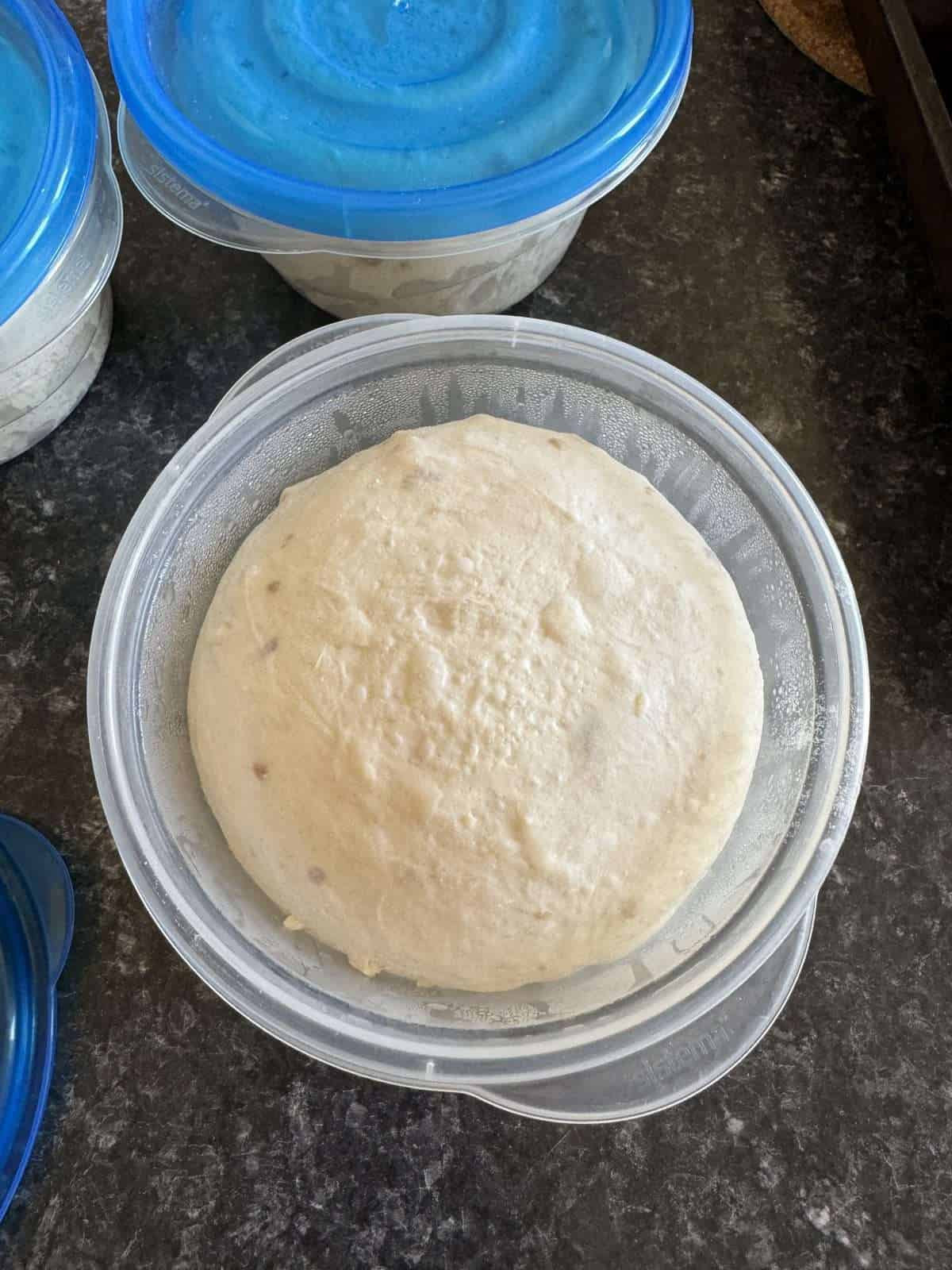
6. Stretching & Baking
To remove a dough ball from its’ container, carefully turn it out onto a floured work surface, gently releasing the dough from the pot with your fingers, if necessary. Make sure to do this carefully, so we don’t squish the dough, releasing the air inside.
There are many ways that you can stretch a ball of dough into a pizza base but the way I like to use is called the “steering wheel” method. This is where we first use our fingertips to press the dough into a disc (leaving a border round the outside) then hold it in the air & rotate it in our hands (like turning a steering wheel), pinching around the crust as we do so. This way, we’re letting gravity do the stretching for us.
When shaping, it’s important to keep as much gas in the dough as possible. This is key to getting a good oven spring & crust.
Once shaped, we add a thin layer of toppings then cook in a 400°c – 450°c (750°f/840°f) pizza oven for 1-1½ minutes, making sure to turn the pizza regularly with a peel, to stop it from burning.
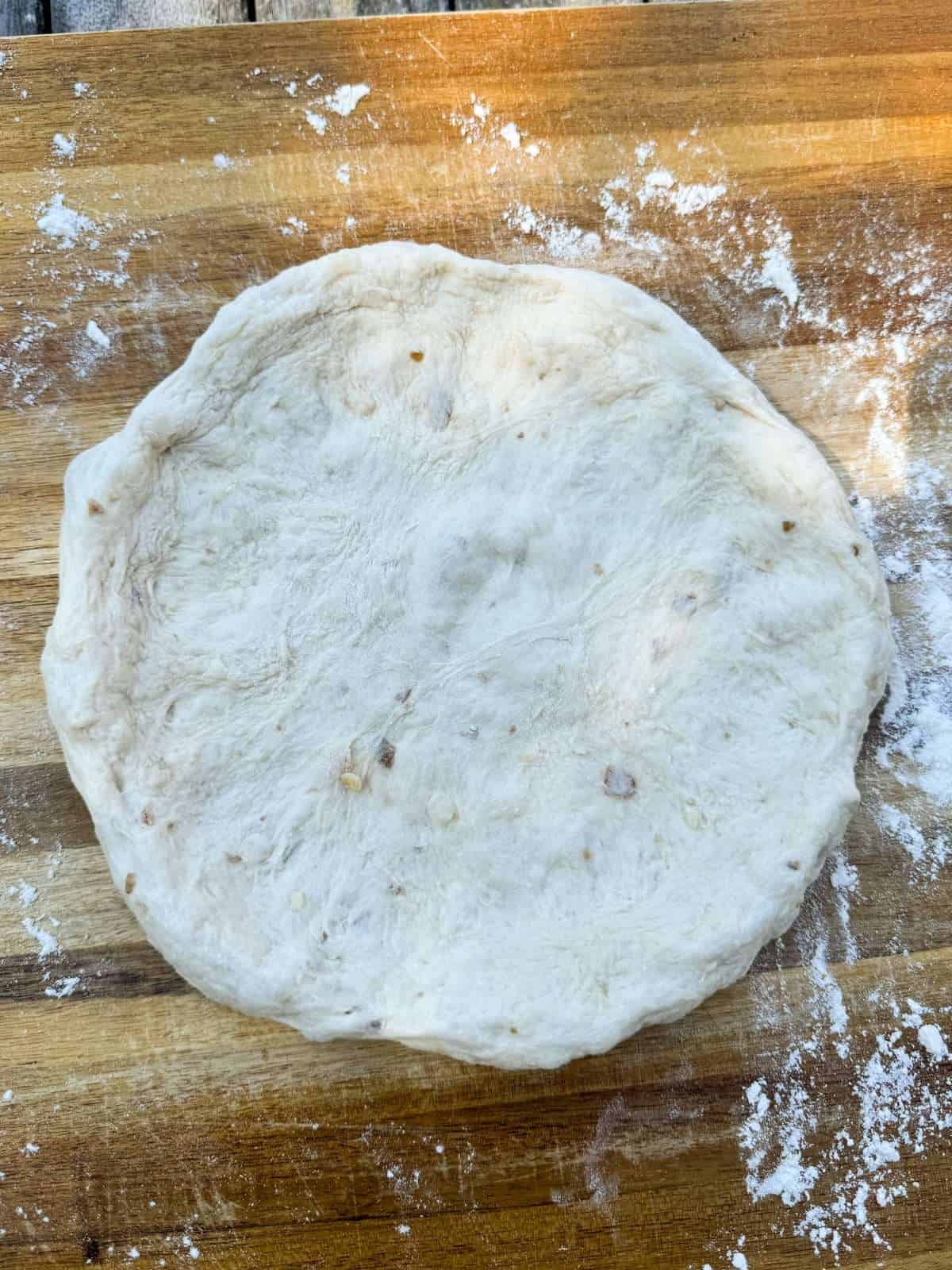
The Windowpane Test
The best way to assess the gluten development in your dough is by using the windowpane test.
Here, you take a small piece of dough & stretch it between your fingers. If it stretches thin enough so that you are able to see through it, enough gluten has been developed. If it tears, more kneading is required.
The Best Way To Cook Pizza
Pizzas are best cooked at a very high temperature, somewhere in the region of 400°c – 450°c (750°f/840°f). The only way that we can achieve these temperatures is by using a pizza oven, fuelled either by gas or wood. The cooking time will be pretty much the same either way.
When I cook pizzas at home, I use a Gozney Roccbox which is fuelled by gas. If you are also using one of these ovens, I’d recommend preheating it for at least 30 minutes, to properly saturate the stone.
Between pizzas, turn the flame to low & to cook, turn the flame up to medium-low.
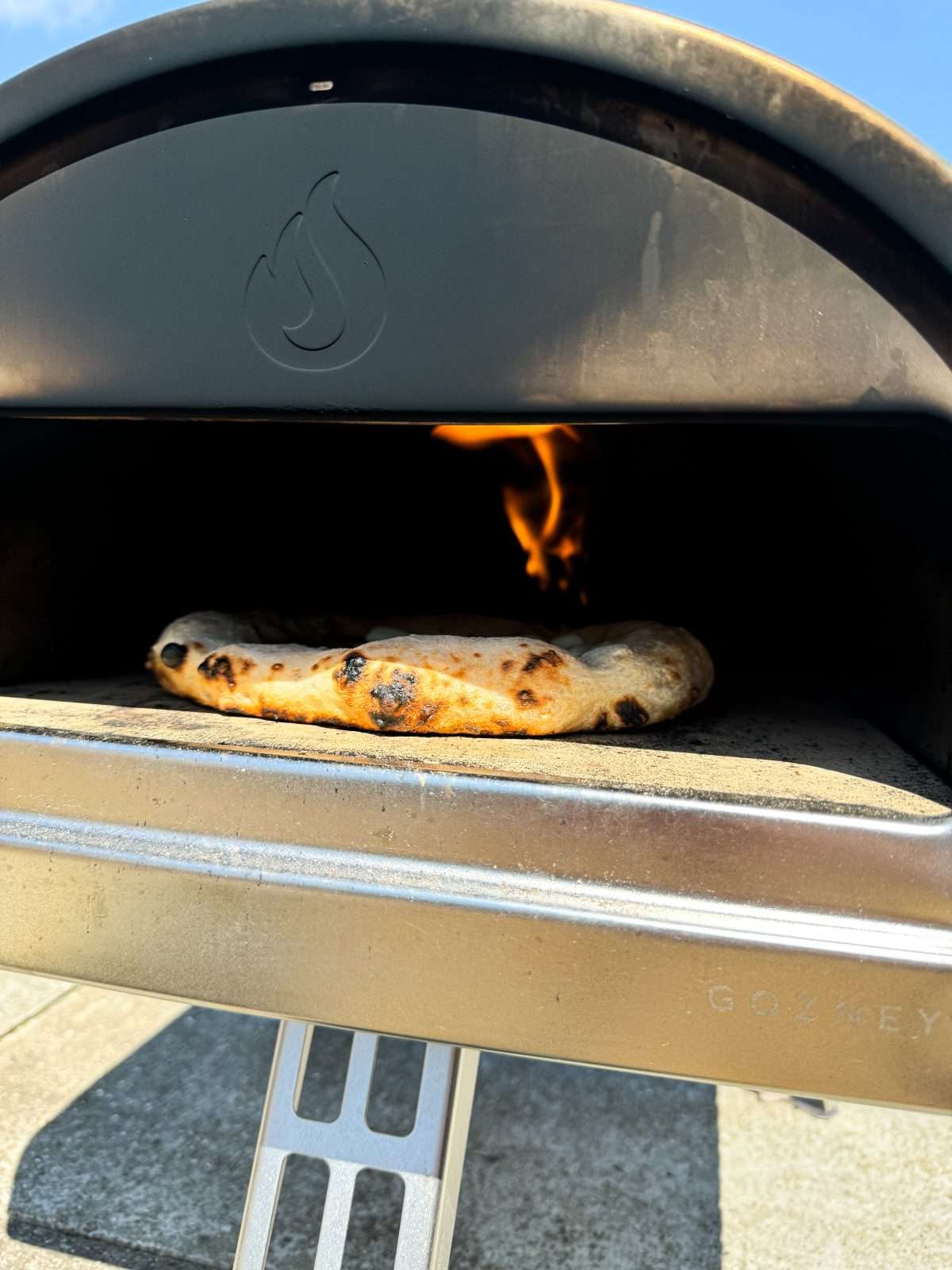
Pizza Dough Tips & Tricks
- Use a pre ferment (like a biga) for extra flavour & an airier crust!
- Make your dough with a good quality 00 flour. I use Caputo.
- Stretch your pizza dough by hand, for the best crust.
- Lightly grease the dough containers with olive oil. This will make removing the dough easier.
- Cook the dough in a pizza oven at 400°c – 450°c (750°f/840°f) & turn regularly, using a peel, to prevent the crust burning.
- Preheat your pizza oven so that the stone is well saturated with heat.
- Use a laser temperature gun for accurate pizza stone temperature readings.
Frequently Asked Questions
00 flour is best used for pizza dough. For our biga potato pizza dough, I’d recommend using Caputo Pizzeria.
Although you can use instant yeast, I find that dried active yeast work better for cold fermented doughs, like this biga pizza dough.
Our biga pizza dough balls need to be fermented in the fridge for at least 18 hours or up to 24. You can cold ferment the dough balls for up to 2 days but keep in mind that the flavour will be more developed.
The biga pizza dough balls need to be taken out of the fridge & left to warm to room temperature before being cooked. Depending on your room temperature, this will take around 1-2 hours.
The best way to stretch this poolish pizza dough is by using the steering wheel method. This is where we use our fingertips to press the dough into a disc (leaving a border round the outside) then hold it in the air & rotate it in our hands (like turning a steering wheel), pinching around the crust as we do so. This way, we’re letting gravity do the stretching for us. There are other methods of stretching that can be used but I find that this way is the easiest.
Although you’ll get the best oven spring & flavour when using a pizza oven to cook this pizza dough, you can use a regular home oven instead. To do this, turn your oven to its’ highest setting & preheat with a metal sheet or baking stone inside. Cook the pizza directly on the hot stone. Keep in mind that it might take a couple of minutes extra.
Equipment Used
Please note that these are affiliate links & I may make a small commission if you make a purchase using these links, at no extra cost to you. For more information, click here.
- Gozney Roccbox
- Stand Mixer
- Thermapen Food Probe
- Potato Ricer
- Caputo 00 Flour
- Individual Dough Containers
More Bread Recipes To Try!
- 3 Day Poolish Pizza Dough
- Potato Burger Buns
- Overnight Potato Focaccia
- Pizza Oven Pittas
- Everything Bagels – New York Style
- English Muffins
If you have enjoyed this 100% biga potato pizza dough recipe, it would mean a lot if you could leave a review & rating. And if you’d like to stay up to date with future recipes, follow us on Instagram & TikTok!
100% Biga Potato Pizza Dough
Equipment
- Stand Mixer
- Digital Food Probe
- Pizza Oven
- 5 Round Storage Tubs With Lids
- Mixing Bowls
- Bench Scraper
Ingredients
Biga
- 3 g Dried Active Yeast
- 215 g Water (20°c/68°f)
- 480 g 00 Flour (See Notes)
Potato Dough
- 1 Large Floury Potato (Around 200g – See Notes)
- 1 tbsp Vegetable Oil
- 85 g Water (20°c/68°f)
- 15 g Fine Sea Salt
Instructions
Biga
- Add the yeast & water into a large mixing bowl then whisk, to combine.
- Add the flour into the water then mix by hand, to hydrate. It's important not to make a dough here, the biga should look clumpy & shaggy.See the post above for a visual guide!
- Cover the mixing bowl with clingfilm, poke a small hole in the top then leave to ferment at 16°c-18°c (60°f-64°f) for 16-18 hours.Once fermented, you should see tiny bubbles around the sides of the bowl (I'd recommend using a transparent bowl!).
Potato Dough
- Preheat an oven to 200°c/180°c fan (390°f/350°f).
- Place your potato onto a baking tray, drizzle with the vegetable oil then bake in the preheated oven until the skin is crispy & the inside is soft. This will take around 30 minutes – 1 hour.Use a sharp knife to check that the potato is cooked all the way through.
- Let the potato cool slightly then cut in half & scoop out the flesh. Use a potato ricer (or fork) to mash the potato then weigh out 120g.
- Chop the crispy potato skin into small pieces then add into the mash potato. Leave to cool to room temperature.
- Add the biga into the bowl of a stand mixer, along with the potato & 40 grams of the water. Mix on a low speed for 4-5 minutes, until combined & smooth then add in the salt & remaining 45 grams of water.
- Continue mixing the dough on low until the water & salt have been incorporated then turn the speed up to medium & continue mixing until the dough passes the windowpane test. This will take another 4-5 minutes.See the post above for more info on the windowpane test.
- Transfer the dough to a lightly oiled bowl & leave to rest at room temperature for 40 minutes. Give the dough a set of coil folds halfway through.The coil folds are optional but helps strengthen the dough.
- Next, tip the dough out onto a lightly floured work surface, divide into 4 equal pieces then shape into balls. Each ball of dough should weigh around 230 grams.
- Lightly oil 4 round storage containers then place a ball of dough into each & cover with a lid (or clingfilm).
- Place the dough into the fridge & leave to ferment for 18-24 hours.
- The next day, take the dough out of the fridge & allow to come to room temperature. This will take 1-2 hours.
Making Pizza
- Take a ball of dough & gently turn out onto a floured work surface.
- Using your fingertips, press the dough into a disc. Starting from the centre & working to the edge, making sure to leaving a 2-3 cm border (this will be the crust).
- To stretch, I like to use a method know as "The Steering Wheel" stretch. Here's how…Using both hands, pick the dough up from one edge & hold it in front of you like a steering wheel. Now rotate the dough in your hands, pinching to form a crust as you do so. As the dough rotates, gravity will stretch it into a large circle.With this method you have full control on the thickness of the crust. If you'd prefer a thinner crust, pinch the dough nearer the edge. For a thicker crust, pinch more towards the centre.
- Top the dough with a light layer of toppings then cook in a pizza oven at 400°c – 450°c (750°f/840°f) for 1-1½ minutes turning regularly with a peel to stop it burning.



